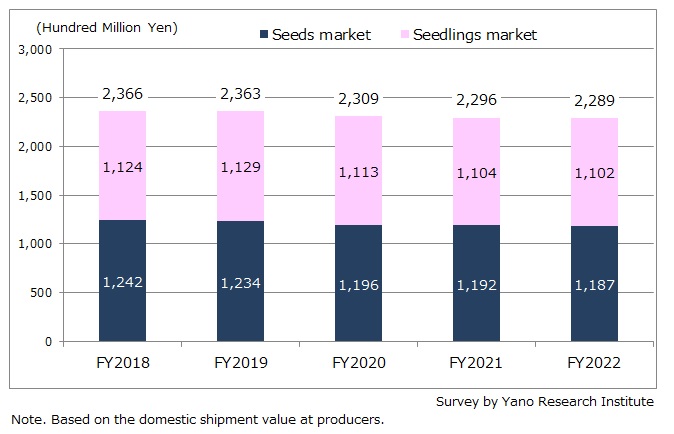No.3410
Seed & Seedling Market in Japan: Key Research Findings 2023
A Total Size of Domestic Seeds and Seedlings Market for FY2022 Attained 99.7% of Previous Fiscal Year to 228,900 Million Yen
Yano Research Institute (the President, Takashi Mizukoshi) has conducted a survey on the domestic market of seed business in Japan, and found out the trends by crop, the trends of market players, and future perspective.

Market Overview
The entire domestic seed and seedling market size in FY2022 slightly declined to 99.7% of the size of the previous fiscal year, based on the shipment values at producers (manufacturers), to 228,900 million yen, among which the seed market occupying 118,700 million yen which was 99.6% of the size of the preceding fiscal year. The seed market continued being somewhat on the fall due to decreasing farming population and crop acreage, increasing lands in fallow, aging farming people, and lack of successors.
On the other hand, despite the continued trend of labor saving by converting to seedlings from seeds, due to decline in demand for fruit trees and lawn grass/turfs, the seedling market in FY2022 fell slightly to 99.8% of the size of the previous fiscal year to 110,200 million yen. Nonetheless, as labor saving and machine sowing has been advancing in agriculture and gardening fields for growing vegetables and flowers, the increase of grafted seedlings*1, plug plants*2, and mericlones*3 continue to be prominent.
*1 Grafted seedling is a type of seedling that is produced by joining (grafting) a scion of one plant into a rootstock of another plant to make them into one plant. Grafted seedlings acquire advantages of both plants, resistance to diseases/ pests/repeated cultivation damage, gain superior productivity, and are easy to grow.
*2 Plug plants are small-sized seedlings grown in cell seedling trays. Currently, plugs plants are used in transplanting of many vegetables and flowers. Automatic seedling transplanters has been saving labor in vegetable production.
*3 Mericlone: A plant that has been produced via cultural technique by taking out a millimeter size of meristem from a new bud to propagate in a germfree incubator. This enables the production of a large number of genetically identical seedlings in a short period of time.
Noteworthy Topics
Penetration of New Technologies Considerably Increases Efficiency in New Plant Breeding
In the market of seeds and seedlings, the use of genome editing, environmental control, and new plant breeding technology like grafted seedling has rapidly expanded. While it is generally said to take up to 50 years to breed a new plant, these new techniques have shortened the development period to few years. Moreover, the use of patented techniques for conjugating different varieties have expanded a range of targets of genome editing.
Showing a certain degree of understanding to the safety of genetic modification, the Japanese government has been promoting the societal introduction of products derived from genome editing technologies. The “notification system for genome edited food and agricultural products” that started in October 2019 provided the simplified pathway for commercializing genome-edited foods, by requiring only reporting of technology details and eliminating requirement for safety assessments, as long as the products do not contain any genes from other species. The notification process for nutrition-enriched high GABA tomato was completed in December 2020, followed by two products of texture-enhanced high amylopectin corn varieties in March 2023. Of the three products, the GABA-enriched tomatoes are being commercialized already for general consumers.
As of November 2023, the number of new plant breed development accumulated to 10 cases in the last 7 years, indicating that the development is completed more than one per year. The research targets other than the two varieties mentioned earlier (the GABA-enriched tomatoes and high amylopectin corns) are rice plants with improved yield, solanine-free potatoes, tomatoes that do not need pollinating to produce fruit, and white Japanese morning glory. Introduction of new technologies are being facilitated to a wide variety, including crops, vegetables, fruits trees, and flowers.
Future Outlook
Growing food services and ready-to-eat food industry are the major target applications for Japanese seed and seedling business to expand their businesses. Still, considering the shrinkage of domestic consumption against the backdrop of low birth rate and aging population, and considering that population of other Asian countries are projected to multiply for years, overseas markets are becoming more appealing for the Japanese seed and seedling makers.
However, the development of overseas business requires more than just exporting products to local retail channels. Makers need to develop breeds that adapt to local climate, natural features, and food culture, and provide instructions for cultivating those breeds. In order for seed and seedling manufacturers to develop overseas business, it is essential for them to establish a region-based marketing in respect of cultivation environment and dietary habits of the locals.
Research Outline
2.Research Object: Manufacturers of seeds and seedling, organizations and government office concerned
3.Research Methogology: Face-to-face interviews by our expert researchers (including online interviews), survey via telephone, questionnaire, and literature research
What is the Seed and Seedling Market?
The seed and seedling market in this research refers to the market of seeds and seedlings to grow domestic agricultural produce which includes vegetables, fruits, grains, flowers, lawn grasses/turfs, fodder, and etc. The market size is calculated based on the domestic shipment values at producers (manufacturers).
<Products and Services in the Market>
Seeds and seedlings (of vegetables, fruits, crops, flowers, lawn grass/turfs, fodder, etc.)
Published Report
Contact Us
The copyright and all other rights pertaining to this report belong to Yano Research Institute.
Please contact our PR team when quoting the report contents for the purpose other than media coverage.
Depending on the purpose of using our report, we may ask you to present your sentences for confirmation beforehand.